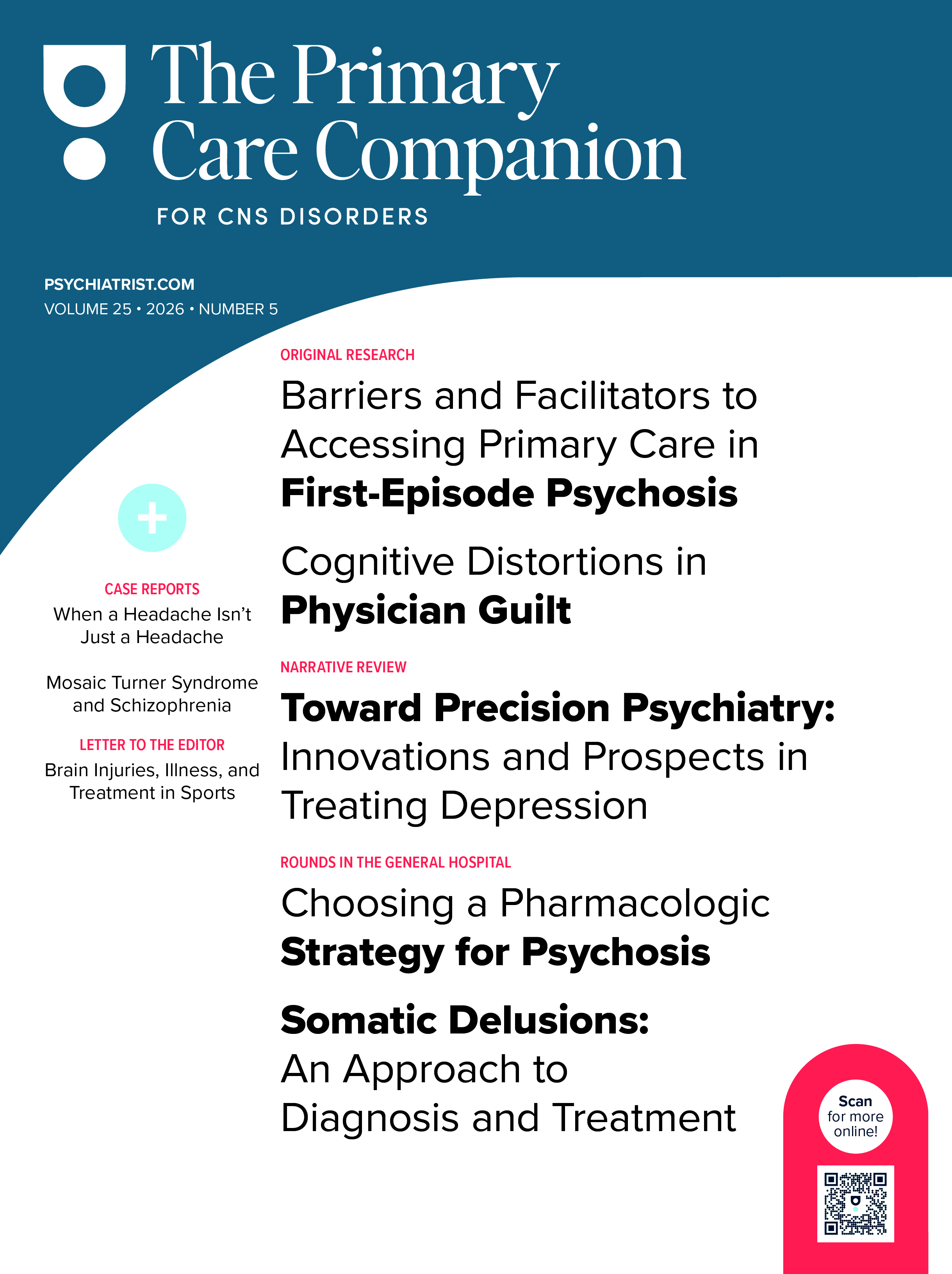The assessment of altered mental status or any acute behavioral changes requires a careful history, as well as physical and laboratory evaluation. The differential diagnosis is also broad, and all potential contributors must be thoroughly investigated, especially in elderly patients with multiple medical or neuropsychiatric comorbidities.1 Acute behavioral changes can be due to a variety of factors, including electrolyte derangements, metabolic abnormalities, infection, and polypharmacy.2 Furthermore, treatment of severe behavioral symptoms, such as aggression, in patients with dementia can compound these symptoms and make them worse. Additionally, in patients with dementia, up to 90% may experience behavioral and psychological symptoms of dementia (BPSD), otherwise known as neuropsychiatric symptoms of dementia. These symptoms include, but are not limited to, depression, apathy, anxiety, aggression, and psychosis and are typically progressive over the natural course of a patient’s dementia diagnosis.3
Here, we present the case of a patient with a past medical history of dementia who resided in a long-term care facility. She was being treated with multiple psychotropic medications for behavioral issues, but her symptoms of aggression, tremulousness, and restlessness continued to worsen. We provide a discussion of the assessment of acute/ subacute behavioral symptoms in patients with dementia and highlight that such cases often do not have a single underlying cause.
Case Report
An 83-year-old widowed white woman was referred to a geriatric psychiatrist due to sudden confusion and a decline in appetite. She was a resident of a long-term care facility due to a diagnosis of late-onset Alzheimer disease. Her other medical history was significant for hypertension, diastolic congestive heart failure, chronic obstructive pulmonary disease, hyperlipidemia, osteoporosis, rheumatoid arthritis, gastroesophageal reflux disease, asthma, and type 2 diabetes mellitus. Prior to admission to this long-term care facility, her psychiatric medications included donepezil 10 mg daily for memory impairment, citalopram 20 mg daily for depression and anxiety, and trazodone 100 mg at bedtime for insomnia.
Since her admission to the facility, her behavioral symptoms were progressively worsening, manifesting as verbal and physical aggression towards nursing staff and frequent outbursts of “help, help,” which disrupted the ward. To manage these symptoms, additional psychotropic medications were added to her regimen and included buspirone 5 mg daily, divalproex extended release 250 mg twice daily, and risperidone oral solution 1 mg every 12 hours as needed. Although these adjustments initially led to reduced aggression, she remained restless and stopped eating.
A comprehensive evaluation by a geriatric psychiatrist revealed that the patient was largely disengaged and appeared both apprehensive and sedated. Her affect was flat and mildly anxious. She was not oriented to person, place, or time. In response to her persistent lack of improvement with the medication changes, her entire medication regimen was re-evaluated. She was tapered off donepezil and citalopram; buspirone and risperidone were discontinued, and trazodone was reduced to 50 mg at bedtime. Concurrent laboratory evaluation revealed a blood valproic acid level elevated to 47 mcg/mL.
Initially, the patient showed some signs of improvement. She was less restless but continued to remain somnolent. Unfortunately, during this period, the patient experienced a fall from her bed while unattended, necessitating inpatient hospitalization for further evaluation and stabilization. At the hospital, her vital signs remained stable, and basic blood work was mostly unremarkable except for an elevated thyroid-stimulating hormone level and low T4. Computed tomography scans of the head and spine and pelvic X-ray were negative for acute fracture. Following stabilization, she was discharged back to her long-term care facility on divalproex extended release 250 mg twice daily and trazodone 50 mg at bedtime. With these adjustments, her behavior remained manageable, but there was no significant improvement in her mental status. Due to her lack of improvement, additional laboratory evaluation was ordered, and her ammonia level was elevated at 72 umol/L, prompting a gradual taper of divalproex. Over the next 3 weeks, she became more alert and less somnolent; however, her cognitive functions did not improve. Given the lack of overall improvement in her cognitive function and ongoing poor quality of life associated with her multiple chronic medical conditions, her family decided to transition her to hospice care.
Discussion
There is a wide differential diagnosis for acute behavioral changes in elderly patients. In a patient with an established diagnosis of dementia, it may be tempting to ascribe new behavioral problems to the natural course of dementia and make a diagnosis of BPSD.3 However, medical comorbidities, living in a long-term care facility, or treatment with multiple psychotropic drugs, as in this case, can all contribute to delirium.4 Delirium is common, but underrecognized. The evaluation of mental status changes in patients with dementia has to carefully consider the patient’s baseline, history of present illness, and current medication regimen to evaluate for any reversible causes of behavioral changes before ascribing symptoms to progression of dementia. Often, treatment of underlying causes will improve mental status, but in patients with multiple underlying causes, this may not be as straightforward.
Polypharmacy is a prevalent issue in long-term care facilities due to the complex medical needs of elderly patients who frequently have multiple chronic conditions that require pharmacologic management. In a systematic review, researchers found that 91% of residents were taking more than 5 medications, and 65% of residents were taking more than 10 medications.5 While polypharmacy aims to address various health issues simultaneously, it introduces significant risks and challenges that can affect patient safety and quality of care. Challenges and risks of polypharmacy include increased risk of drug interactions, adverse drug reactions, difficulty in monitoring and managing side effects, challenges in medication adherence, and increased risk of falls and functional decline.
Divalproex, a derivative of valproic acid, is commonly used to treat seizure disorders and certain psychiatric conditions. The reported incidence of valproic acid–induced hyperammonemia varies widely across studies, with one study reporting the incidence of this side effect as high as 36%.6 Valproic acid is metabolized by the liver, and it exhibits significant differences in clearance between individuals, especially when other hepatically metabolized medications are coadministered. Additionally, elderly patients are at increased risk for supratherapeutic levels of valproic acid due to decreased drug plasma protein binding and reduced clearance of the drug by the liver.7 While the use of this agent is generally considered safe in elderly patients, it is important to consider other factors that could influence hepatic metabolism and even consider regular testing of valproic acid in patients determined to be at high risk. This includes patients with complex past medical histories and those receiving many medications, further increasing their risk for polypharmacy as mentioned previously.
This diagnostically challenging case underscores the importance of considering a wide differential diagnosis in the elderly patient with behavioral changes and highlights the importance of careful prescribing and medication management practices in the long-term care setting. While divalproex can be an effective treatment for mood stabilization, its potential to cause hyperammonemia necessitates stringent monitoring of both symptoms and blood drug levels in at-risk patients. Addressing the complexities of caring for patients in a long-term care setting and interprofessional collaboration between nursing, pharmacy, and medical teams are vital for optimizing patient care.
Article Information
Published Online: August 7, 2025. https://doi.org/10.4088/PCC.25cr03950
© 2025 Physicians Postgraduate Press, Inc.
Prim Care Companion CNS Disord 2025;27(4):25cr03950
Submitted: February 25, 2025; accepted May 15, 2025.
To Cite: Molotkova E, Kwok J, Kim K. Sudden confusion in a patient treated with divalproex. Prim Care Companion CNS Disord 2025;27(4):25cr03950.
Author Affiliations: Virginia Polytechnic Institute and State University Carilion School of Medicine, Roanoke, Virginia (all authors); Carilion Clinic Center for Healthy Aging, Roanoke, Virginia (Kim).
Corresponding Author: Kye Kim, MD, Carilion Clinic Center for Healthy Aging, 4434 Electric Rd, Roanoke, VA 24018 ([email protected]).
Relevant Financial Relationships: None.
Funding/Support: None.
Additional Information: Information has been de-identified to protect patient anonymity.
References (7)

- Patti L, Gupta M. Change in mental status. [Updated 2023 Aug 7]. StatPearls [Internet]. StatPearls Publishing; 2024. Accessed June 12, 2024. https://www.ncbi.nlm.nih.gov/books/NBK441973/.
- Cloak N, Schoo C, Al Khalili Y. Behavioral and psychological symptoms in dementia. [Updated 2024 Feb 27]. StatPearls [Internet]. StatPearls Publishing; 2024. Accessed July 2, 2024. https://www.ncbi.nlm.nih.gov/books/NBK551552/.
- Bessey LJ, Walaszek A. “Management of behavioral and psychological symptoms of dementia”. Curr Psychiatry Rep. 2019;21(8):66. PubMed CrossRef
- Inouye SK, Westendorp RG, Saczynski JS. Delirium in elderly people. Lancet. 2014;383(9920):911–922. PubMed CrossRef
- Jokanovic N, Tan ECK, Dooley MJ, et al. Prevalence and factors associated with polypharmacy in long-term care facilities: a systematic review. J Am Med Dir Assoc. 2015;16(6):535.e1–e1-.e12. PubMed CrossRef
- Baddour E, Tewksbury A, Stauner N. Valproic acid–induced hyperammonemia: incidence, clinical significance, and treatment management. Ment Health Clin. 2018;8(2):73–77. PubMed CrossRef
- Perucca E, Grimaldi R, Gatti G, et al. Pharmacokinetics of valproic acid in the elderly. Br J Clin Pharmacol. 1984;17(6):665–669. PubMed CrossRef
Please sign in or purchase this PDF for $40.





